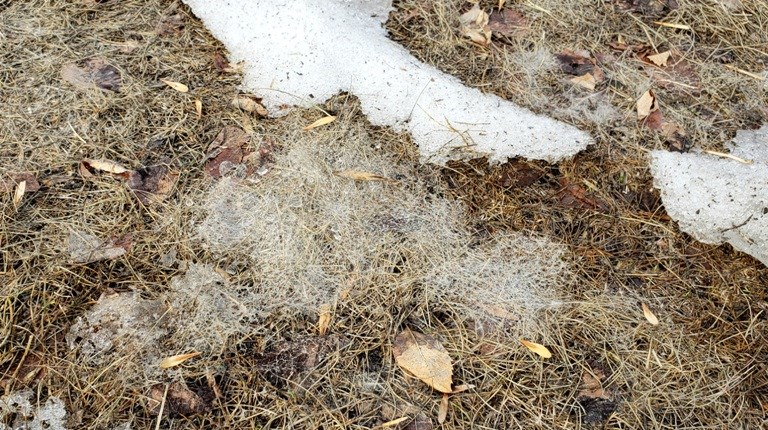When we go into Awinter with a heavy snowfall before the ground is fully frozen, we expect to see more snow mold in the early spring. Snow mold is a fungal condition that affects lawn or turf areas in early spring and appears in the early spring while the snow is melting and the surface temperature of the ground approaches 0 C. This fungal issue is tough on the lawn but also bad news for allergy sufferers.
Early spring is always a dirty time with lots of dust blowing around and, especially this year, we expect to also enjoy lots of mold spores. Itchy, watery eyes and respiratory symptoms in early spring are often in response to snow mold on lawn areas. If you have sensitivity to spores, then as the collection of snow is disappearing and all you want to do is go outside, you may need to take some precautions. The spores, which are the tiny reproductive particles of fungi/molds, can cause more problems than pollen as they are smaller particles and can get deep into the lungs.
Not only does snow mold make allergy sufferers miserable, it can also cause severe damage on lawn areas. There are a number of fungi that can be involved including: Typhula spp., Microdochiumnivale, Sclerotinia borealis, non-sclerotial low temperature basidiomycete (LTB), and sclerotial low temperature basidiomycete (SLTB). While the snow is melting you may see patches of spider web like material on the turf surface. This is the mycelium, which is the vegetative part of a fungus, that hugs the lawn as the snow recedes. Damage shows up on the turf as circular dead patches that are anywhere from a few inches to a foot in diameter. When damage is severe it often appears like the whole lawn area is affected.
The greatest damage will be in the more shaded damp areas where the snow takes a little longer to melt away. This year, due to the heavy snow cover the snow mold will likely be especially bad. The fungi are able to grow at temperatures right around the freezing point but the spores will survive over the summer and are easily spread through mowing or foot traffic. It will not usually kill off the entire turf areas but it may take most of the summer for affected turf to recover.
You can reduce the amount of snow mold that occurs by ensuring you do not over fertilize your lawn later in the summer. High levels of nitrogen make plant tissue soft and succulent and more susceptible to injury. Using a slow release fertilizer is generally a better idea than a quick-release fertilizer late in the season. It is also important to continue to mow the lawn until all growth has stopped and to clean up leaves that have dropped on lawn areas. Reduce excess thatch by mowing correctly, aerating and power raking if necessary. Avoid compaction by avoiding walking on lawn areas, even on top of the snow.
Snow mold injury is often superficial and only affects leaf blade tissue. However, when infestation is severe, the entire plant may die. On areas that have been affected, lightly rake to encourage drying. Try not to breathe in the spores or the dust that will be present even if you do not generally get allergic reactions. As the season progresses you may want to overseed larger areas to help hasten the recovery.
Hanbidge is the lead horticulturist with Orchid Horticulture. Find us at ; by email at [email protected]; on facebook @orchidhort and on instagram at #orchidhort.




